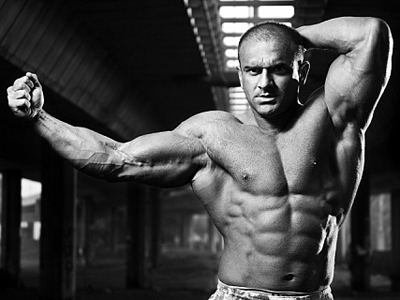The number and speed of repetitions for the development of various physical qualities
The speed, or time, of performing repetitions is an important parameter of the load during strength training, which is not always correctly used. For example, in bodybuilding circles, it is widely believed that when working with a load exceeding 85 percent of the repeated maximum, weight lifting should be done slowly, but in fact this condition is not mandatory. Strength athletes who develop explosive weight lifting can work quickly under load up to 95 percent of the repeated maximum and show a high level of energy production even under such a high load.
The whole point is to train the nervous system in order to activate all motor units within the shortest possible period of time. This effect is achieved by periodizing the strength training program and switching from inter-muscle coordination training (explosive work under medium and high load) to intramuscular coordination training (explosive work under maximum load or at least an attempt at explosive work). See the table in the article Adaptation to physical exertion.
To develop maximum strength (i.e. work under a load of 70-100 percent of the repeated maximum), the number of repetitions should be small (from one to five); see table 8 in the articleGradually increasing the load. For exercises aimed at developing power (i.e., work under a load of 50-80 percent of the repeated maximum), the number of repetitions should be from small to medium (from one to 10 dynamic repetitions). For the development of short-term muscle endurance, training with a number of repetitions from 10 to 30 is suitable, while training for medium-term muscle endurance requires from 30 to 60 continuous repetitions, and for the development of long – term muscle endurance requires even more repetitions-up to 200. The suggested number of repetitions may shock trainers who believe that 20 repetitions is enough to develop muscle endurance. However, performing 20 repetitions has little impact on overall performance in sports that require medium – and long-term muscle endurance, such as rowing, kayaking, long-distance swimming, and cross-country skiing.
Table 1 shows the ratio between the load and the possible number of repetitions performed to failure by athletes of two different types. It also follows from this table that re-maximum conversion tables are practically useless, since they do not take into account the individual characteristics of an athlete, which may be at one of the extreme points of the neuro-metabolic range.

Table 1. The ratio between the percentage of repeated maximum and the possible number of repetitions to failure for athletes with an advantage from the neuromuscular system and athletes with an advantage from the metabolic system
| An athlete with a high level of neuromuscular efficiency (power) | An athlete with a high level of metabolic efficiency (endurance).) | |
| % repeated maximum | Repetitions | Repetitions |
| 100 | 1 | 1 |
| 95 | 1-2 | 2-3 |
| 90 | 3 | 4-5 |
| 85 | 5 | 6-8 |
| 80 | 6 | 10-12 |
| 75 | 8 | 15-20 |
| 70 | 10 | 25-30 |
| 65 | 15 | 40-50 |
| 60 | 20 | 70-90 |
| 50 | 25-30 | 90-110 |
| 40 | 40-50 | 120-150 |
| 30 | 70-100 | 150-200 |
Speed is an important factor in strength training. To achieve maximum effect, the repetition rate should be high and explosive for most exercises, at least for the concentric phase. The correct use of speed is that the athlete applies force against resistance. For example, when an American football player, thrower, or sprinter running under high load (over 90% of the repeated maximum), the movement may look slow, but the application of force against resistance is carried out at the highest possible speed. Otherwise, the nervous system does not engage and activate with maximum frequency all the motor units necessary to overcome resistance. Only as a result of a quick and vigorous application of force does training intentionally involve the fibers of rapidly contracting muscles occur. Strictly speaking, in accordance with the results of recent studies that have considered the implementation concentric efforts to lift the weight to the maximum expected velocity and speed, lower half, while performing movements at maximum speed for six weeks, a doubling of the maximum force in comparison with the increase of the maximum force at slow weight lifting, as well as increase the speed at all loads.
For this reason, the speed of muscle contraction plays a very important role in strength training. In order to achieve explosive effort, the athlete needs to focus on quick muscle activation, even when the bar is moving slowly. Although most of the time the barbell should move quickly. Fast-twitch fibers are instantly activated only at high contraction rates under heavy load (over 70 percent re-maximum), resulting in an increase in maximum force and power.
Repetition time also has a significant impact on the physiological response during strength training, and this factor is directly related to the duration of muscle tension during the approach; see Table 2. Accordingly, the speed of movement should change, depending on the stage of training. Table 3 shows the rep times for each step of the strength training program.
At a moderate speed of the concentric phase, the metabolic tension and expression of muscle strength increases over the range of motion, and this speed can be used to increase the hypertrophic response to training. Moderate speed is used at the stage of anatomical adaptation, because in this situation the athlete has better control of movement, and the muscles are under pressure for a longer period of time. The eccentric part of the weight lift can last for three to four seconds, followed by a one-second pause to move from the eccentric phase to the concentric phase, and then two seconds fall on the concentric phase. However, in the remaining stages of the annual plan, athletes should perform the concentric phase of strength training at high speed and in an explosive manner, since most sports require fast concentric contractions.
The desired rate of contraction should be as high as possible in stages where the focus is on maximum strength, power, strength endurance, and short-term muscle endurance. During the maximum strength stage, athletes should slowly perform three to four eccentric actions, followed by an explosive concentric action. At this stage, the athlete can control the transition from an eccentric action to a concentric one. In fact, the best way to maximize the concentric force is to remove all reflex or flex characteristics developed during the eccentric phase of weight work by pausing for one to two seconds before performing the concentric phase. These techniques should be used at an early stage of the maximum strength training phase.
Table 2. Training results in accordance with the change in the time of performing repetitions
| MUSCLE ACTION | ECCENTRIC
PHASE |
ISOMETRIC PHASE BETWEEN ECCENTRIC AND CONCENTRIC PHASES | CONCENTRIC LINE
PHASE |
ISOMETRIC PHASE BETWEEN CONCENTRIC AND ECCENTRIC PHASES | ||||
| TIME
IMPLEMENTATIONS |
Slow motion
(3-5 sec.) |
Fast () | Absent | Present (1-5 sec.) | Slow motion
(2-3 sec.) |
Fast () | Absent | Present (1-2 seconds)) |
| EFFECT
TRAINING |
Raising
hypertrophy |
Decline
hypertrophy |
Decline
hypertrophy |
Increased hypertrophy | Raising
hypertrophy |
Raising
max. forces |
Raising
metabolic voltage levels |
Increased activation of fast-twitch fibers |
| Max power boost | Raising
cyclical starting point forces |
Increasing cyclic starting power | Increase in acyclic starting power | Raising
metabolic voltage levels |
Raising
nervous voltage levels |
|||

Table 3. Suggested rep times depending on the training stage
| Eccentric
phase |
Isometric phase between eccentric and concentric phases | Concentric line
phase |
Isometric phase between eccentric and concentric phases | Example of the suggested runtime | |
| AA | Slow | Is present | Slow or fast | Absent | 3.0.2.0 |
| Gip. | Slow | Present or absent | Fast | Absent | 4.1.1.0 |
| MS | Slow | Present or absent | Fast | Missing or present | 3.0. X. 1 |
| M | Fast | Missing (cyclic), present (acyclic) | Fast | Missing or present | 1.0. X. 0 |
| SV | Fast | Missing (cyclic), present (acyclic) | Fast | Absent | 1.0. X. 0 |
| CMS | Fast | Absent | Fast | Absent | 1.0.1.0 |
| CMB | Moderate | Absent | Fast | Absent | 2.0.1.0 |
| DMV | Moderate | Absent | Moderate | Absent | 2.0.1.0 |
Conventions: AA – anatomical adaptation, Gip. – hypertrophy, DMV-long-term muscle endurance, SMV-medium-term muscle endurance, CMV-short-term muscle endurance, MS – maximum strength, M-power and SV-strength endurance.
As an example, consider the bench press in the prone position. When performing this exercise, the concentric part consists of extending the arms, and returning the barbell to chest level and stretching the chest muscles is an eccentric part. Simply put, the exercise consists of the following sequence: the athlete slowly bends his arms to bring the bar closer to his chest, then quickly returns it to its original position and starts the cycle again. On the other hand, the eccentric part of the work can increase the strength of the subsequent concentric part, if the eccentric part is also performed quickly, resulting in a so-called myotatic reflex. This reflex is the reason for the special popularity of plyometric training in sports. In essence, plyometric training improves an athlete’s performance by improving the physiological properties of the main driving muscles to perform fast and explosive concentric actions.
When the athlete quickly lowers the bar to the chest, neural mechanisms in the muscles are activated, and the elastic energy used during the concentric phase or lifting stage of the bar accumulates in the ligaments. Thus, a net increase in the generated concentric force can be achieved by pausing after the eccentric phase, which eliminates the positive effect of the eccentric phase. This approach makes it possible to standardize the range of motion of each rep and does not allow the athlete to cheat and push the weight away. As a result, intermuscular coordination is improved as a result of improved technique.
This approach can also be used to help the athlete overcome the training plateau. The trainer must determine the priority, which can be the deliberate maximization of concentric force or the imitation of a specific neuromuscular algorithm (usually an action that includes an eccentric and concentric phase). In the end, at the stage of maximum strength, priority should be given not to the first, but to the second.
The time required for performing repetitions is directly related to the duration of the approach and represents the interval during which the muscles are under tension during the repetition. If you multiply this time period by the number of repetitions, you can determine the total duration of the approach. For each stage of training, there is an optimal way to perform each rep, depending on the training effect that is the goal of this stage. This specificity also applies to the duration of the approach, which depends on the energy system of the body involved. Table 4 shows the training effect for different variants of the approach duration.

